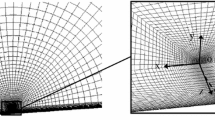Abstract
The photoelastic analysis of crack tip stress intensity factors has been historically developed for use on sharp notches in brittle materials that idealize the cracked structure. This approach, while useful, is not applicable to cases where residual effects of fatigue crack development (e.g., plasticity, surface roughness) affect the applied stress intensity range. A photoelastic model of these fatigue processes has been developed using polycarbonate, which is sufficiently ductile to allow the growth of a fatigue crack. The resultant stress field has been modeled mathematically using the stress potential function approach of Muskhelishvili to predict the stresses near a loaded but closed crack in an elastic body. The model was fitted to full-field photoelastic data using a combination of a generic algorithm and the downhill simplex method. The technique offers a significant advance in the ability to characterize the behavior of fatigue cracks with plasticity-induced closure, and hence to gain new insights into the associated mechanisms.
Similar content being viewed by others
Abbreviations
- A k ,a k :
-
Fourier series coefficients
- d :
-
mean difference between theoretical and experimental stress values
- i :
-
square root of −1
- m :
-
mapping function shape descriptor
- r, θ:
-
polar coordinates in the mapping plane
- s :
-
standard deviation in the difference between stress values
- t :
-
distance from the crack tip
- x, y :
-
Cartesian coordinates in the physical plane
- z :
-
complex coordinate in the physical plane
- B :
-
rigid body translation of the mapping plane
- C :
-
rigid body rotation of the mapping plane
- K I ,K II :
-
mode I and II stress intensity factors
- K max :
-
maximum value of stress intensity factor
- P :
-
pressure loading on the crack
- R :
-
mapping function length descriptor
- T :
-
shear loading on the crack
- α:
-
principal stress direction at infinity
- κ:
-
material constant
- ν:
-
Poisson's ratio
- σ1, α:
-
maximum principal stress at infinity
- σ2, α:
-
minimum principal stress at infinity
- τ r θ:
-
shear stress
- ω:
-
mapping function
- ζ:
-
complex coordinate in the mapping plane
- Γ:
-
rigid body movement of the mapping plane
- Ε, Γ:
-
complex stress functions
References
Irwin, G.R., “Discussion of the Dynamic Stress Distribution Surrounding a Running Crack—A Photoelastic Analysis,”Proceedings of the Society for Experimental Mechanics,16,93–96 (1958).
Sanford, R.J., andDally, J.W., “A General Method for Determining Mixed Mode Stress Intensity Factors from Isochromatic Fringe Patterns,”Engineering Fracture Mechanics,11,621–683 (1979).
Nurse, A.D., andPatterson, E.A., “Determination of Predominantly Mode II Stress Intensity Factors from Isochromatic Data,”Fatigue and Fracture of Engineering Materials and Structures,16,1339–1354 (1993).
Picon, R., Paris, F., Canas, J., andMarin, J., “A Complete Field Method for Photoelastic Determination of K I and K II in General Mixed Mode Fracture,”Engineering Fracture Mechanics,51,506–516 (1996).
Schroedl, M.A., McGowan, J.J., andSmith, C.W., “An Assessment of Factors Influencing Data obtained by the Photoelastic Stress Freezing Technique for Stress Fields near Crack Tips,”Engineering Fracture Mechanics,4,801–809 (1972).
Karpenko, M., andWu, Q., “Photoelastic Validation of a Theoretical Solution for an Edge Cracked Disk,”EXPERIMENTAL MECHANICS,43 (4),410–419 (2003).
Elber, W., “Fatigue Crack Closure Under Cyclic Tension,”Engineering Fracture Mechanics,2,37–45 (1970).
Budiansky, B., andHutchinson, J.W., “Analysis of Closure in Fatigue Crack Growth,”Journal of Applied Mechanics,45,267–276 (1978).
Newman, J. C. Jr. A Crack-closure Model for Predicting Fatigue Crack Growth under Aircraft Spectral Loading,” Methods and Models for Predicting Fatigue Crack Growth under Random Loading, ASTM STP 748, Chang, J. B. and Hudson, C. M., editors, American Society for Testing and Materials, 53–84 (1981).
James, M.N., “Some Unresolved Issues with Fatigue Crack Closure—Measurement, Mechanism, and Interpretation Problems,” Advances in Fracture Research, Proceedings of the 9th International Conference on Fracture, Sydney, Australia, Vol. 5, Karihaloo, B.L. et al., editors, Pergamon Press, Amsterdam, 2403–2414 (1997).
Donald, J.K., “Introducing the Compliance Ratio Concept for Determining Effective Stress Intensity.International Journal of Fatigue,19 (S1),S191-S195 (1999).
James, M.N. andKnott, J.F., “An Assessment of Crack Closure and the Extent of the Short Crack Regime in QIN (HY 80) Steel,”Fatigue and Fracture of Engineering Materials and Structures 8, (2),177–191 (1985).
Suresh, S., Fatigue of Materials, 2nd edition, Cambridge University Press, Cambridge (1998).
Pacey, M.N., James, M.N., andPatterson, E.A., “A Photoelastic Study of Plasticity Induced Crack Wake Contact Stresses in Polycarbonate Specimens,”Proceedings of the 7th International Fatigue Congress, Beijing, China, Vol. 4, 2819–2824 (1999).
Muskhelishvili, N.L., Some Basic Problems of the Mathematical Theory of Elasticity, Noordhoff, Groningen (1953).
Pacey, M.N., James, M.N. and Patterson, E.A., “On the Use of Photoelasticity to Study Crack Growth Mechanisms,” Proceedings of the IX SEM International Congress on Experimental Mechanics, Orlando, FL, 375–378 (2000).
Goldberg, D.E., Genetic Algorithms in Search Optimization and Machine Learning, Addison-Wesley, Reading, MA (1989).
Moscato, P., On Evolution, Search, Optimization, Genetic Algorithms and Martial Arts: Towards Memetic Algorithms, Caltech Concurrent Computation Program, C3P Report 826 (1989).
Nelder, J.A. andMead, R., “A Simplex Method for Function Minimization,”Computer Journal,7,308–313 (1965).
Parker, A.P., The Mechanics of Fracture and Fatigue, E.&F.N. Spon, London (1981).
Gungor, S. andPatterson, E.A., “A Photoelastic Determination of Stress Intensity Factors for Corner Cracks in a Bolted Joint,”Journal of Offshore Mechanics and Arctic Engineering, Transactions of the ASME,119,276–280 (1997).
Srawley, J.E., “Wide Range Stress Intensity Factor Expressions for ASTM E399 Standard Fracture Toughness Specimens,”International Journal of Fracture,12,475–476 (1976).
Wei, L.-W. andJames, M.N., “A Study of Fatigue Crack Closure in Polycarbonate CT Specimens,”Engineering Fracture Mechanics,66,223 (2000).
Author information
Authors and Affiliations
Rights and permissions
About this article
Cite this article
Pacey, M.N., James, M.N. & Patterson, E.A. A new photoelastic model for studying fatigue crack closure. Experimental Mechanics 45, 42–52 (2005). https://doi.org/10.1007/BF02428989
Received:
Accepted:
Issue Date:
DOI: https://doi.org/10.1007/BF02428989




